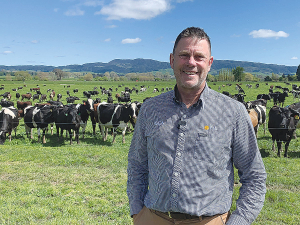Alliance commissions major heat pump system at Mataura, cutting coal use and emissions
Alliance Group has commissioned a new heat pump system at its Mataura processing plant in Southland.
 Dairy companies are realising that preventing mastitis, not just treating it, results in more milk in the vat,” says Colin May, FIL.
Dairy companies are realising that preventing mastitis, not just treating it, results in more milk in the vat,” says Colin May, FIL.
Building on their groundbreaking work in mastitis prevention, FIL, a subsidiary of GEA Farm Technologies New Zealand, is collaborating with Farm Medix to introduce innovative solutions to enhance milk quality, improve profitability, and combat anti-microbial resistance (AMR).
“Over the past six years, FIL and Farm Medix have recognised and addressed the challenges farmers in New Zealand face with managing mastitis within their herds,” says Colin May, FIL’s national sales manager.
“Over the past six years, FIL and Farm Medix have recognised and addressed the challenges farmers in New Zealand face with managing mastitis within their herds,” says Colin May, FIL’s national sales manager.
The scientists meticulously analyse milk samples from farms across New Zealand. Through advanced pathogen identification techniques, they partner with FIL to create targeted strategies, effectively The scientists meticulously analyse milk samples from farms across New Zealand. Through advanced pathogen identification techniques, they partner with FIL to create targeted strategies, effectively lowering somatic cell counts and reducing clinical mastitis. This scientific precision distinguishes their approach, delivering bespoke solutions the company says are unmatched in accuracy and efficacy. Farm Medix also export their products around the world.
The engagement of FIL’s 19 area managers is pivotal. They collect milk samples and collaborate closely with Farm Medix’s laboratory to developed customised mastitis management plans tailored to each farm’s unique needs and goals – so every farmer receives personalised support to help them to manage and prevent mastitis.
Stephen Begbie, a dairy farmer from Paeroa, credits FIL’s service and support for the significant reduction in mastitis cases on his farm.
“I had been grappling with a significant mastitis problem, the somatic cell count was spiking up and down, reaching as high as 380,000,” he says.
Begbie decided to have his whole herd tested by Farm Medix after a discussion with his FIL area manager. Out of his 320 cows, 30 were identified as having Staph aureus. By segregating these cows from the rest of the herd, milking them last and supplying milk without the Staph aureus cows in the vat, he was able to reduce the somatic cell count from 380,000 to 85,000 in just one day.
This intervention led to a significant reduction in mastitis cases over the last three years. Last year, Stephen only had six cases of mastitis and by taking a selective approach to drying off, he only had to dry cow 10% of his herd.
Begbie strongly believes in the value of lab testing: “It is a more effective approach than herd testing, which only provides results on the day of the test. Lab testing, on the other hand, allows for ongoing monitoring and targeted interventions.”
The cost savings from this approach have been substantial. Stephen estimates that he saved $2,000-$3,000 on dry cowing last year alone because his cell count was so low. He also notes that having fewer mastitis cows in the herd balances out other costs, such as treatments and additional labour.
Lower SCC, Less Antibiotics
FIL says Stephen Begbie’s story is a testament to the effectiveness of its approach to mastitis management.
His experience shows that with the right support and strategies, it is possible to significantly reduce mastitis cases, improve milk quality, and achieve substantial cost savings.
Statistics show that mastitis control, including dry cow therapy, accounts for about 85% of antibiotics used on dairy farms in New Zealand (source DairyNZ). In the United States, mastitis affects approximately 38% of the 9.4 million dairy cow population.
While comparable data specific to New Zealand may vary, this highlights the global significance of addressing mastitis through innovative solutions like those offered by FIL and Farm Medix.
Reducing mastitis, in addition to improving animal welfare, also helps the industry reduce emissions. Healthy herds increase milk production and reduce the overall footprint of dairy farming. A healthier cow translates to increased efficiency, decreased antibiotic usage, and less use of resources.
This shift towards proactive health management enhances farm profitability and mitigates on-farm emissions, aligning with New Zealand’s emission reduction goals.
“Dairy companies are realising that preventing mastitis, not just treating it, results in more milk in the vat,” says Colin May.
“Lowering somatic cell counts and reducing antibiotic usage helps reduce emissions and hit targets. It also has a positive impact on the industry.
“We’ve truly shifted farmer thinking about mastitis through our dedication to innovation and environmental responsibility.
Through evidence-based interventions, we are improving milk quality, increasing herd productivity, and supporting sustainable agricultural practices, both within New Zealand and globally,” says May.
The Push-Up Challenge, an event which combines mental health and fitness, is set to launch in New Zealand in 2026.
Last month's Agritechnica event led to a wide group of manufacturers celebrating successes when the 2026 Tractor of the Year Competition winners, selected by a panel of European journalists, were announced in Hanover Germany.
According to the latest Federated Farmers banking survey, farmers are more satisfied with their bank and less under pressure, however, the sector is well short of confidence levels seen last decade.
Farmer confidence has taken a slight dip according to the final Rabobank rural confidence survey for the year.
Former Agriculture Minister and Otaki farmer Nathan Guy has been appointed New Zealand’s Special Agricultural Trade Envoy (SATE).
Alliance Group has commissioned a new heat pump system at its Mataura processing plant in Southland.
President Donald Trump’s decision to impose tariffs on imports into the US is doing good things for global trade, according…
Seen a giant cheese roll rolling along Southland’s roads?